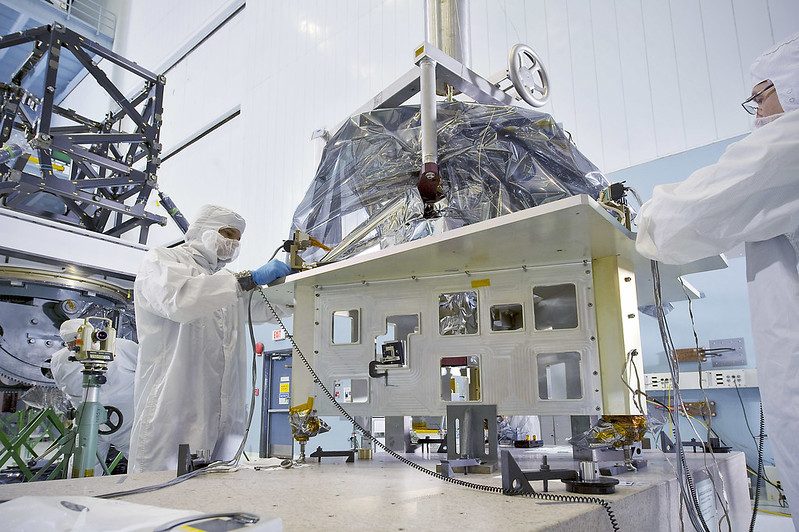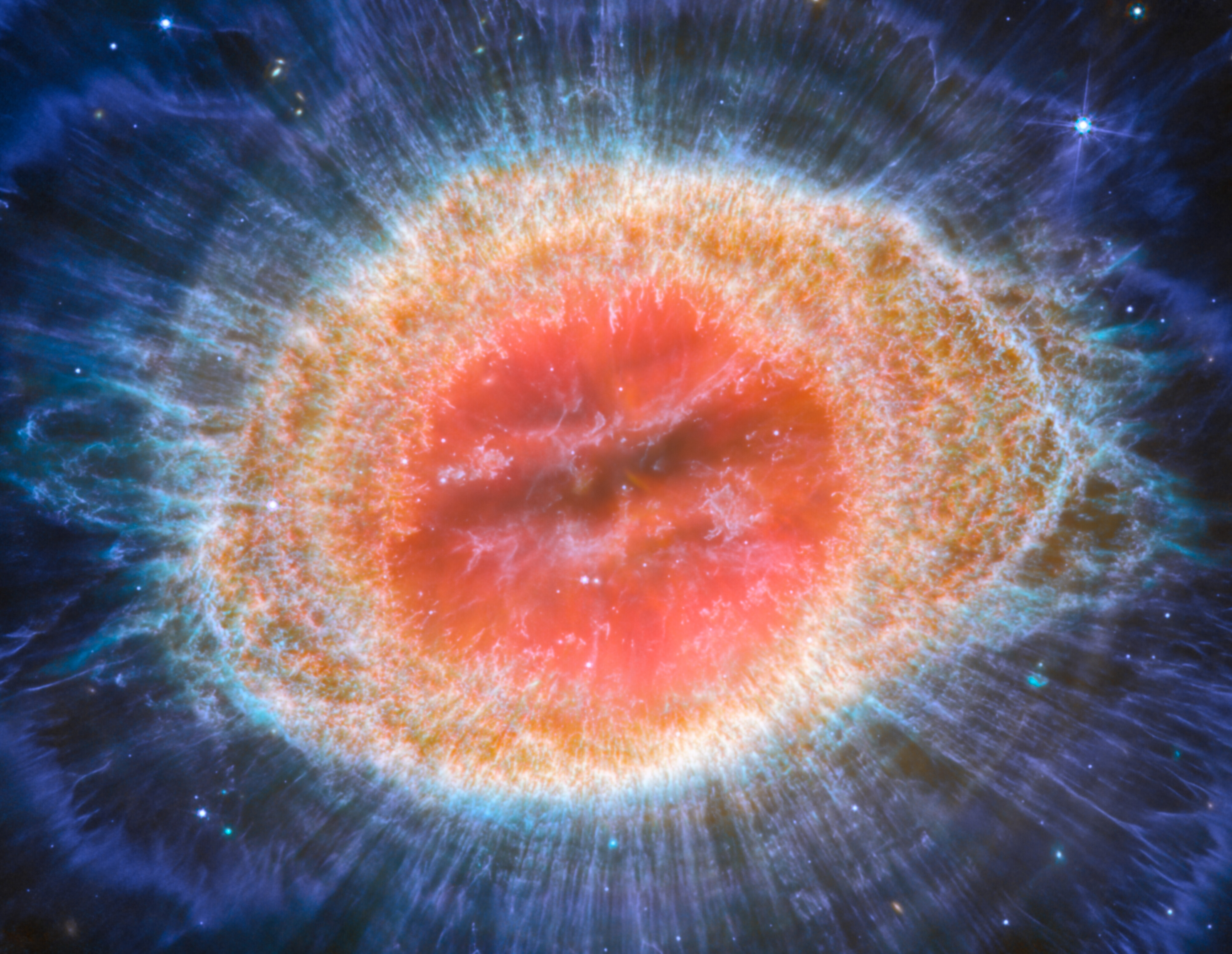The UK ATC led the MIRI European Consortium, who designed, built and tested MIRI (the Mid-InfraRed Instrument), for the James Webb Space Telescope (JWST) in a partnership with NASA Jet Propulsion Laboratory and the University of Arizona.
MIRI is the only instrument on JWST covering the mid-infrared and so it combines a broad range of science functions into one instrument:
- Imaging.
- Coronagraphs that can block the light from a star and reveal images of planets.
- Low resolution spectroscopy that can measure precisely small signal changes as exoplanets orbit their stars.
- Medium resolution integral field spectroscopy that can measure the spectra of dust, molecules, distant galaxies to study their chemical constituents.
The instrument requires a special cooling system which cools the instrument down to its optimal operating temperature of -266°C, more than 30 degrees colder than the rest of the mission, to ensure infrared heat from the observatory does not interfere or drown out the instrument's readings. 
Adding a mid-infrared capability to JWST greatly enhances the science that Webb can address, and MIRI covers the whole range of Webb's science goals, from observing our own Solar System and other planetary systems, to studying the early Universe.
MIRI was the first JWST instrument to be delivered to NASA in 2012, where it was built into bigger and bigger subsystems within the observatory. With continuous testing at every stage of integration, before successfully launching on Christmas Day 2021, and starting science operations in July 2022, providing stunning images of the Universe as never seen before.
The UK ATC led Optical System Design, the packaging, and the scientific performance verification on the ground and during commissioning for the whole instrument, led the development of the MIRI simulator tool MIRISim and algorithms for the data pipeline.
The UK ATC also designed and built the Spectrometer Pre-Optics (SPO). This is the first unit of the spectrometer which houses the image slicer that splits the incoming light into sections and feeds it into the Spectrometer Main Optics where it is further divided into its component wavelengths. This allows scientists to examine the chemical composition of gas clouds, stars and even planetary atmospheres. The SPO includes two dichroic and grating wheel mechanisms (provided by MPIA, Heidelberg, Germany) which are used to select which part of the incoming light the spectrometer measures. We delivered the SPO to our colleagues in RAL Space in 2010, where it was integrated with the other MIRI subsystems and tested before delivery to NASA.
 The enthusiasm and dedication over many years within the MIRI partnership is a significant factor in its success. MIRI drew on the scientific and technical expertise of the following organizations: Ames Research Center, USA; Airbus Defence and Space, UK; CEA-Irfu, Saclay, France; Centre Spatial de Liège, Belgium; Consejo Superior de Investigaciones Cientficas, Spain; Carl Zeiss Optronics, Germany; Chalmers University of Technology, Sweden; Danish Space Research Institute, Denmark; Dublin Institute for Advanced Studies, Ireland; European Space Agency, Netherlands; ETCA, Belgium; ETH Zurich, Switzerland; Goddard Space Flight Center, USA; Institute d'Astrophysique Spatiale, France; Instituto Nacional de Técnica Aeroespacial, Spain; Institute for Astronomy, Edinburgh, UK; Jet Propulsion Laboratory, USA; Laboratoire d'Astrophysique de Marseille (LAM), France; Leiden University, Netherlands; Lockheed Advanced Technology Center (USA); NOVA Opt-IR group at Dwingeloo, Netherlands; Northrop Grumman, USA; Max Planck Institut für Astronomie (MPIA), Heidelberg, Germany; Laboratoire d'Etudes Spatiales et d'Instrumentation en Astrophysique (LESIA), France; Paul Scherrer Institut, Switzerland; Raytheon Vision Systems, USA; RUAG Aerospace, Switzerland; Rutherford Appleton Laboratory (RAL Space), UK; Space Telescope Science Institute, USA; Toegepast-Natuurwetenschappelijk Onderzoek (TNOTPD), Netherlands; UK Astronomy Technology Centre, UK; University College London, UK; University of Amsterdam, Netherlands; University of Arizona, USA; University of Bern, Switzerland; University of Cardiff, UK; University of Cologne, Germany; University of Ghent; University of Groningen, Netherlands; University of Leicester, UK; University of Leuven, Belgium; University of Stockholm, Sweden; Utah State University, USA.
The enthusiasm and dedication over many years within the MIRI partnership is a significant factor in its success. MIRI drew on the scientific and technical expertise of the following organizations: Ames Research Center, USA; Airbus Defence and Space, UK; CEA-Irfu, Saclay, France; Centre Spatial de Liège, Belgium; Consejo Superior de Investigaciones Cientficas, Spain; Carl Zeiss Optronics, Germany; Chalmers University of Technology, Sweden; Danish Space Research Institute, Denmark; Dublin Institute for Advanced Studies, Ireland; European Space Agency, Netherlands; ETCA, Belgium; ETH Zurich, Switzerland; Goddard Space Flight Center, USA; Institute d'Astrophysique Spatiale, France; Instituto Nacional de Técnica Aeroespacial, Spain; Institute for Astronomy, Edinburgh, UK; Jet Propulsion Laboratory, USA; Laboratoire d'Astrophysique de Marseille (LAM), France; Leiden University, Netherlands; Lockheed Advanced Technology Center (USA); NOVA Opt-IR group at Dwingeloo, Netherlands; Northrop Grumman, USA; Max Planck Institut für Astronomie (MPIA), Heidelberg, Germany; Laboratoire d'Etudes Spatiales et d'Instrumentation en Astrophysique (LESIA), France; Paul Scherrer Institut, Switzerland; Raytheon Vision Systems, USA; RUAG Aerospace, Switzerland; Rutherford Appleton Laboratory (RAL Space), UK; Space Telescope Science Institute, USA; Toegepast-Natuurwetenschappelijk Onderzoek (TNOTPD), Netherlands; UK Astronomy Technology Centre, UK; University College London, UK; University of Amsterdam, Netherlands; University of Arizona, USA; University of Bern, Switzerland; University of Cardiff, UK; University of Cologne, Germany; University of Ghent; University of Groningen, Netherlands; University of Leicester, UK; University of Leuven, Belgium; University of Stockholm, Sweden; Utah State University, USA.
The following National and International Funding Agencies funded and supported the MIRI development: NASA; ESA; Belgian Science Policy Office (BELSPO); Centre Nationale d'Etudes Spatiales (CNES); Danish National Space Centre; Deutsches Zentrum fur Luft-und Raumfahrt (DLR); Enterprise Ireland; Ministerio De Economiá y Competividad; Netherlands Research School for Astronomy (NOVA); Netherlands Organisation for Scientific Research (NWO); Science and Technology Facilities Council; Swiss Space Office; Swedish National Space Board; and UK Space Agency.
See some of the scientific results and spectacular images from MIRI.
Find out more about The James Webb Space Telescope and MIRI.
